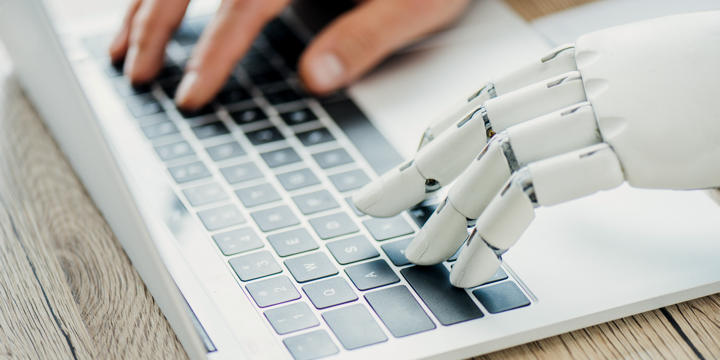Robotics and AI in the workplace: 4 opportunities and 5 challenges
In the past, the primary aim of robotics and AI was the automation of manual tasks. Today, they are becoming an essential part of our day-to-day jobs. As they help us work more efficiently, the boundaries between employees and ‘machines’ becomes more blurry. “The result is a slew of new and exciting opportunities, but quite a few challenges as well”, explains Juan Staes, program manager workplace of the future at delaware.

4 opportunities
1. Supporting older and disabled employees
“As people are expected to work longer, some companies are looking for ways to give older employees a helping hand, especially if their work is physically demanding. For example, there are currently a number of trials with exoskeletons. These suits can help warehouse operatives with back problems to still lift heavy boxes. The same technology can be used to support employees with physical disabilities.”
2. Stimulating intergenerational work
“Imagine a situation in which a technician with 40 years of experience is no longer physically fit enough to visit a job site in person, but a younger colleague with less experience is. VR enables the two of them to work together. The on-site employee puts on a virtual reality headset, while the more experienced colleague can watch the live stream and give precise instructions from the office. It’s a perfect example of how people and technology now go hand in hand.”
3. ‘Talking’ to applications with NLP
Natural Language Processing or NLP will open up completely new ways for employees to interface with day-to-day applications. For example, it will be possible to ask the CRM to present you with specific client information through chat or voice recognition. Need an update on the supply of raw material? A quick call to the ERP system suffices.
4. Intelligent automation
RPA currently operates similarly to an assembly line robot, executing a predefined set of tasks. In the near future, it will be possible to infuse them with machine learning abilities. This will allow bots to ‘learn’ from human operators, allowing them to tackle increasingly complex tasks. Other possibilities include image recognition and text analysis. This combination of automation and artificial intelligence, called ‘intelligent automation’, will help organizations reach unprecedented levels of efficiency.
“In less than ten years from now, we won’t be able to imagine a world without robotics and AI. This will have an impact on everything from legal, insurance, education and training aspects to job descriptions.”
5 challenges
Apart from these challenges, there are a number of challenges related to AI and robotics in the workplace as well. Here’s a few of them.
1. Legal aspects
From driverless cars to intelligent production machines, the question remains: if something goes wrong with a robot, who is responsible?
2. Change management
For a long time, AI and robots have been predicted to ‘take over people’s jobs’. However, that really isn’t the case anymore. In fact, they support faster, more efficient, and more substantiated decision making. This mental shift will take some time to fully develop. A carefully managed transition and good communication are key.
3. Ethical aspects
The ‘ratings’ logic of apps like TripAdvisor can be expanded to recruitment of consultants and job applicants as well. But the question is whether that’s actually allowed, not only in terms of privacy but ethics as well. How far can and should we go?
4. Learning on the job
Working with an exoskeleton, or with robots or AI in general, has a major impact on people’s on-the-job learning and training. This needs to be carefully considered as well.
5. Taking a proactive approach
While huge technological progress is being made, the HR department – and other departments as well - needs to be willing to not only work with it, but fully embrace it as well. Involving the business in the discussion is essential. Whereas HR is currently using technology for mainly administrative purposes, it needs to think about new ways to make the most of the presented opportunities. This requires a proactive rather than a reactive approach.
Want to know more about the future of AI in the workplace? Reach out to one of our experts.



